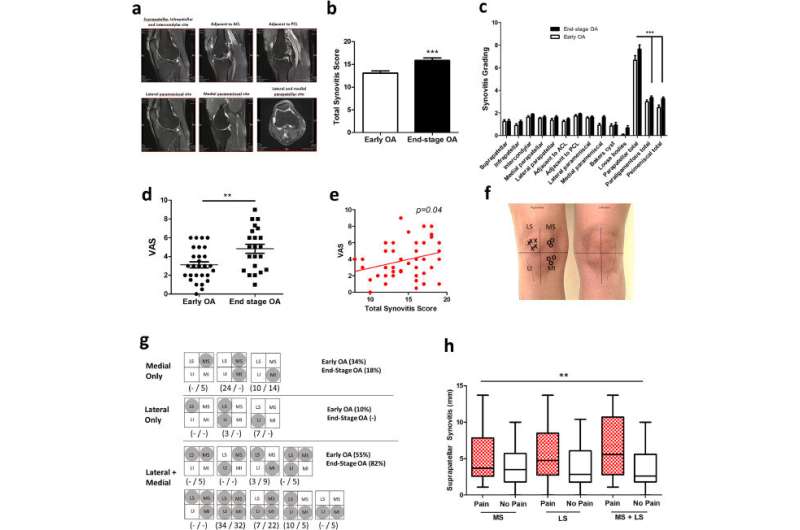Specific cell population plays a key role in the effect arthritis has on the body and the pain patients feel

Scientists at the University of Birmingham have led a study which has identified a new specific population of cells that plays a key role in the effect arthritis has on the body and the subsequent pain felt by patients.
The research team, led by scientists from the University of Birmingham's Institute of Inflammation and Ageing, conducted a clinical trial involving 52 patients with osteoarthritis—a condition that causes joints to become painful and stiff and the most common type of arthritis in the UK.
All of the patients had osteoarthritis in their knee and were aged between 35 and 85. 29 of the patients had early stage disease, while 22 had end-stage disease.
The study saw the team, including experts from the University of Bath and Birmingham's Royal Orthopaedic Hospital, measure levels of inflammation of the lining of the knee joint at different anatomical sites around the knee joint using MRI scans.
Patient-reported pain severity and pain location was recorded using a knee map, where patients marked the anatomical location of where they felt most pain and where they felt least pain or no pain. The researchers then collected joint lining tissue biopsies from parts of the knee where patients reported feeling pain, as well as areas where patients felt no pain.
Corresponding author Dr. Simon Jones, of the University of Birmingham's Institute of Inflammation and Ageing, said: "Inflammation of the joint lining membrane is a known characteristic feature of osteoarthritis. However, its association with joint pain has previously not been clear because both the amount and specific location of inflammation and the location and severity of pain varies amongst patients.
"Our findings showed that in patients with osteoarthritis of the knee, inflammation of the joint lining membrane tissue was associated with both the location and severity of patient reported joint pain.
"Critically, for the first time we were able to demonstrate that joint lining tissue at the site of patient-reported pain contained a different gene signature, with specific populations of cells—called synovial fibroblasts—that promoted joint inflammation and the growth and survival of nerve cells."
A gene signature contains information about the activity of a specific group of genes in a cell or tissue. Gene signatures can show how likely certain diseases of conditions can develop or spread and can be used to help diagnose disease, make a prognosis and plan treatment.
Dr. Jones added: "Current pain relief medications for patients with knee osteoarthritis are limited in their effectiveness and can cause adverse side effects. Our data provides the rationale to develop therapeutic drugs that are designed to control the activity of specific joint lining cells in order to alleviate joint pain in osteoarthritis patients."
The research, funded by Versus Arthritis, was carried out over a period of almost four years and is published in the journal EBioMedicine.
More information: Dominika E Nanus et al, Synovial tissue from sites of joint pain in knee osteoarthritis patients exhibits a differential phenotype with distinct fibroblast subsets, EBioMedicine (2021). DOI: 10.1016/j.ebiom.2021.103618



















